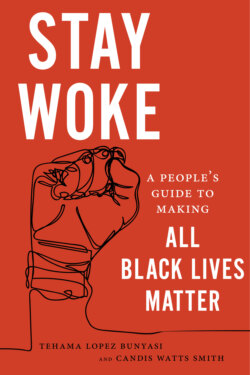Stay Woke

Реклама. ООО «ЛитРес», ИНН: 7719571260.
Оглавление
Candis Watts Smith. Stay Woke
STAY WOKE. A PEOPLE’S GUIDE TO MAKING. ALL BLACK LIVES MATTER
Contents
Introduction
Who Should Read This Book?
How Should You Use This Book?
One Last Thing
1. On the Matter of Black Lives
Some Uncomfortable Facts
Police, Crime, and Justice
FAQ
Location, Location, Location
Education
Employment
Income and Wealth
Health
When Black Lives Matter
Questions and Debate
Additional Materials to Consider. BOOKS
FILMS
PODCASTS
WEBSITES
2. All the Words People Throw Around
FREQUENTLY ASKED QUESTION
AN EXERCISE IN ACTIVISM
TRANSLATING MICROAGGRESSIONS
A THOUGHT EXPERIMENT
SPACE FOR DEBATE
Questions and Debate
Additional Materials to Consider. BOOKS
PODCASTS
3. The Politics of Racial Progress
A Lesson in Nonlinearity
A Lesson in Concessions and Co-optation
The Allure of the Almost There
A Note on Being Labeled “Radical” and “Un-American”
Questions and Debate
Additional Materials to Consider. BOOKS
FILMS
WEBSITES
PODCASTS
4. Are You Upholding White Supremacy?
“It Doesn’t Matter If You’re Black or White or Green or Blue!”
“I Voted for Obama”
“I Did Not Vote for Trump”
“When Old People Die, We Will Finally Be Done with Racism”
“All Lives Matter”
“If Only He Weren’t Wearing a Hoodie”
Flipping the Script
Questions and Debate
Additional Materials to Consider. BOOKS
CHILDREN’S BOOKS
5. It Doesn’t Have to Be This Way
Lesson #1: Here’s What They Want
Lesson #2: You Can Be a Leader!
Lesson #3: Inequity Is a (Local) Policy Choice
STATE BUDGETS = STATE VALUES
WHOSE VOTES MATTER?
CRIME AND PUNISHMENT
BE THE CHANGE
Questions and Debate
Additional Materials to Consider. BOOKS
FILMS
PODCASTS
WEBSITES
6. Twenty-One Affirmations for the Twenty-First Century
1. We Are Leaderful
2. Racism Is Tyrannical, and Democracy Is Fragile
3. Progress Is Not Inevitable
4. We Don’t Need to Be Perfect. We Need to Be Political
5. Interrogate Meritocracy
6. Children Are Our Barometer
7. Reappropriate the Language of Morality
8. Read Widely
9. Beware of Woker-than-Thou-itis!
10. Yield Silently to Those Who Are Seldom Heard
11. Second-Class Citizenship Must Be Eradicated
12. Reparations Can Mean Many Things
13. No Election Is Too Small
14. Someone Is Counting on You to Do Nothing at All
15. Division of Labor Is a Beautiful Thing
16. Collective Action Is and Has Been Powerful
17. Calibrate Your Time Scales
18. Be for Something
19. Have Fun!
20. Do unto Others as You Would Have Them Do unto You
21. Dream Big!
Conclusion. We Believe That We Will Win!
Acknowledgments
Notes. INTRODUCTION
1. ON THE MATTER OF BLACK LIVES
2. ALL THE WORDS PEOPLE THROW AROUND
3. THE POLITICS OF RACIAL PROGRESS
4. ARE YOU UPHOLDING WHITE SUPREMACY?
5. IT DOESN’T HAVE TO BE THIS WAY
6. TWENTY-ONE AFFIRMATIONS FOR THE TWENTY-FIRST CENTURY
CONCLUSION
Bibliography
Index
ABOUT THE AUTHORS
Отрывок из книги
TEHAMA LOPEZ BUNYASI AND CANDIS WATTS SMITH
NEW YORK UNIVERSITY PRESS
.....
As mentioned, these HOLC categories were developed nearly eighty-five years ago, but their influence still reverberates today. We can think of neighborhoods and suburbs such as Levittown in New York and Pennsylvania (built by the same Levitt & Sons family business) that did not allow Blacks to buy for decades and today are still overwhelmingly white. While people were able to buy homes for about $7,000 in the early 1940s, today homes in Levittown, New York, are sold for upwards of $500,000. Meanwhile, in neighborhoods on the West Side of Chicago, where Blacks were segregated and made to rely on predatory financing, some homes twice the size of those in Levittown may be purchased now for around or even less than $150,000. This area is still predominantly Black.
Relatedly, in the case of Durham, North Carolina, the areas that were “redlined” in the 1930s, such as Wall Town, are still predominantly Black and low income today (although this area is undergoing gentrification). And the Green areas, such as Trinity Park, are still wealthy and white. These HOLC maps even influence the location of trees in the city! In the 1940s, the city of Durham planted trees in the Green neighborhoods. Now, the city cannot afford to plant trees in the Red areas, where low-income Blacks still live today, because they have to use money to maintain the trees in areas that were historically white and still are today. Research shows that trees influence levels of pollution in the air, which means that there may be more pollution in Black neighborhoods than in white neighborhoods.35 This specific kind of inequality is referred to as environmental racism, but as we see here, this is business as usual. Nobody needs to do anything sinister for this kind of inequity to persist.
.....